-

人教版新目标初中英语七年级下册How was your weekend教案2篇
Teaching Goal:1. General aims:Talk about recent past events2. Particular aims:A. Language Focus.Talk about recent past events and think of the past events.B. Language goalsHow was….?It was …What did …do over the weekend?C. Language structures:(1). How was your weekend? I was great. Pay attention to no form.(2). What did you do over the weekend? I played soccer. We went to the beach.D. Useful words and phrases:Words: was, did, went, beach, over, project, test, wasn’t, false, number, geography, spend, week, most, mixture, their, had, little, cook, read, saw, change, everyone, sit, sat, no, anythingPhrases: did one’s homework, played soccer, cleaned my room, went to the beach, played tennis, went to the movies, on Saturday morning, over the weekend, cook … for, what about, do some reading, have a party, talk show, go shoppingE. Grammar language:Present simple past tenseRegular and irregular verbsF. Learning strategies:Tour and holidaysG. Interdiscipinary:H. Emotion and manner:Teaching time: 5 periodsTeaching procedures:Period One教学步骤、时间 教师活动 学生活动 媒体应用Step 1Free talk 3’ Ask some questions like:Who’s on duty today?What’s the weather like? Answer and talk about something.让同学们回答下列问题1. Do you like weekend? (Let some students answer)It takes them three minutes to talk about the question.2. Why do you like weekend? (let the students answer) Most of the students like the weekend此时教师用汉语问:“在周末期间问你干了什么?这句话用英语这么回答?Let the students guess.At last the teacher give them right answer3. What did you do over the weekend?(板书、学习)

人教版新目标初中英语七年级下册What does he look like教案3篇
所需要用到的句子:Who is that?That is Jack. I like him.Why do you like him?I like him because he is interesting.Task 4: 设计理想中的人类Step one: 设计理想中的人类的外貌。把全班同学分成若干小组,学生可以边说边在纸上画出他们的模样。Step two: 设计理想中人类的性格。学生们可以把那些能描述性格的单词写在图画的旁边。Step three: 每组选出一名同学,其他同组同学提问,他作简单回答,并说明原因。所需用到的句子:What does he or she look like?He or she ...What is he or she like?He or she is ...Why?Because ...Task 5: 挑战性活动调查性格是天生的还是后天形成的,让每个同学回家去调查一下自己成长过程中性格是否有变化,具体是怎样的,为什么会这样? Teaching Aims:1. Enable students to have a general understanding of how to talk about people's physical appearance.2. Enable students to tackle some essential vocabularies and patterns about describing people. Provide them with necessary skills and methods.3. Create various chances for students to describe the persons they're familiar with, such as classmates, family members, teachers, idols, etc.

人教版新目标初中英语七年级下册Where is the post office教案2篇
Period 2 (3a----Section B 2c)Preview(Pre-task): Key points: What laAdd another information about their pen pals----their language on the cardnguage does she/he speak?She/He speaks....Does she/he have any brothers and sisters? Does she/he speak English?Preview(Pre-task): Add another information about their pen pals----their language on the cardKey points: What language does she/he speak?She/He speaks....Does she/he have any brothers and sisters? Does she/he speak English?Step 1 Revision1.Revisionand dictation of the new words 2.Revise the drills they learned yesterday.(by pairwork and grammar exercise)Step 2 Leading-inT has a conversation with one student. The conversation is following:---Do you have a pen pal?---Yes, I do.---What's your pen pal's name? ---His/Her name is....---Where is your pen pal from? ---He/She is from...---Where does he/she live? ---He/She lives in....---What language does he/she speak?He/She speaks...Write the new words on the Bb. They are following: EnglishChineseJapaneseFrenchStep 3 LearnLearn the new words with the whole class.Finish 3a with the students3b Pairwork T still does an example with one student Then the Ss practise in pairs. The example is following:--Curry Muray is my pen pal. He is from the United States.---What language does he speak?

人教版新目标初中英语七年级下册I ’d like some noodles教案
教学过程Step 1: warming-up Sing a song---------“food and drink” Step 2: Revision1 Dictation2 Revise: What kind of noodles would you like?I’d like …What size bowl of noodles would you like?I’d like…Step 3: Presentation1 show pictures of food, ask students say the words.2 Students read the newspaper ad in 3a. Fill in blanks with words in the box. Then read the ad together, the teacher explains some difficult language points.3 Check the answers Step 4 PracticeAsk students to finish 3b in the same way according to 3a. Students read the short passage and fill in the blanks .At last, check the answers.Step 5 productionAsk students to write their own ad for dumplings, noodles, drinks, and other foods they know. Then ask students to read their partner’s ad. Then order food and drink from their partner.Step 6 Home workGroup work – make an ad about “food and drink”

人教版新目标初中英语七年级下册I want to be an actor教案2篇
三、教学建议第一课时:1. Lead in (Vocabulary)A) Before class, teacher should collect some pictures of working places. For example: Bank, TV Station, Restaurant, Police Station, Hospital ...B) In class, show students the pictures (PowerPoint, OHP). Ask students to tell the name of the working places and the name of the jobs.Shop assistant, doctor, actor, reporter, police office, waiter, bank clerk, studentC) Do exercise 1a and 3a.2. Bingo GameAsk groups of students to make up pairs of cards with a job on one and the related workplace on the other. For example, waiter / restaurant, teacher / school, doctor / hospital. Encourage students to use both the job / workplace combinations in the book and the ones that students came up during class discussions. Be sure they have twice as many sets of cards as there are students in the group. They can make two sets of cards for a single job / workplace, if necessary. Then have each group mix up its set of cards and hand their cards out in random order. Each time a student gets a pair of cards that match, he or she can lay these cards down. The goal is to have no cards in your hand at the end.3. Task OneA) Ask students to work in pairs and ask the partner what does he / she want to be in the future.e. g. :What do you / does he / does she want to be?I want to be a.Why?Because it's (adj).B) Vocabulary: Section B, 1a4. Homework 1.2.

人教版新目标初中英语七年级下册What do you think of game shows教案
五、教学Section B-2c1. Pair work: What do you think of the belt/sunglasses/…? What does your father/mother/… think of your scarf/belt…?2. Group work(1). Teacher shows some different kinds of school uniforms (制服)and asks : “ What do you think of your school uniforms? If you have a chance to choose your school uniforms, what kind would you like to choose?”(2). Discuss in groups.(3).Get some Ss to report in class.说明:这一步旨在让学生运用已有的语言知识谈论对事物的看法和意见,并简单阐明理由,培养学生的主动思维能力和运用英语的能力。六、教学拓展调查电视节目的收视率任务:调查你周围的人对现在各种电视节目的反响。活动过程:1.教师布置任务,让学生调查周围的人(包括他的亲戚朋友和邻居)喜欢收看哪方面的电视节目。2.学生进行调查活动,运用本单元所学的句型What do you think of….? (Why?)What's your favorite game shows?What do you think of talk show?I doesn’t mind it.I like it.I love it.I can’t stand it.3.记录下排在前10位的TV Program,填写调查表,比较其收视率。

人教版新目标初中英语七年级下册Why do you like koalas教案2篇
单元整体说明(一)单元教材分析本单元的核心话题是描述动物和表达个人喜好,以及句式why do you like…? Because…。这也是本单元的教学重点。通过本单元的学习,学生应能较流利地运用所学词汇和句型描述动物,表达个人喜好。(二)单元知识结构1.词汇动物名称 tiger, elephant, koala, dolphin, etc.词汇描述性形容词: smart, cute, ugly, clever, shy, etc.国家名: Australia, South Africa2.句型Why do you like koala hears? Because they are cute.Where are pandas from? They're from China.What animals do you like? I like dolphins.(三)单元整体目标1.Master the vocabulary2.Master and use: Why do you like koalas? Because they am cute.Where are pandas from? They're from China.What animals do you like? I like dolphins.(四)单元教学重难点一览(五)单元学情分析学生此前已经学过由why, where, what 引导的特殊疑问句句型,具有了学习本单元知识的认知前提。形形色色的动物能激发学生的好奇心,产生了解它们的欲望,这有利于本单元知识的教学和学生学习兴趣的培养。
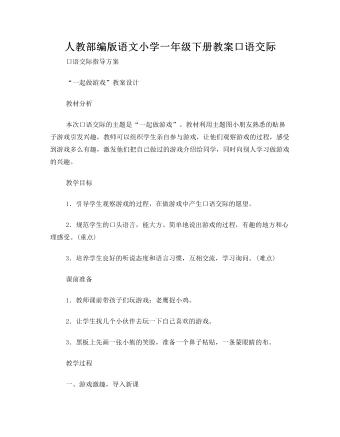
语文小学教案口语交际
分组讨论,交流体会师:小朋友们玩得开心吗?生:太开心了!师:把你最开心的地方说给小组的其他小朋友听一听好吗?每一个小组选一个说得最好的在班上交流。生1:我刚才和我同桌玩的是“反口令”游戏。这个游戏很简单,就是按照口令相反的动作做才对。比如刚才,我让他“摸左耳”,他就得摸右耳,又让他“抬左腿”,他就得抬右腿。当我说道“闭左眼”的时候他就听话了,哈哈!结果他就是这么失败的!生2:这个游戏真考验人的反应啊!生3:我们六个人玩的是“蹲蹲游戏”。我们每个人代表一个词语:萝卜、白菜、西瓜、土豆、苹果、橘子。我们站成一排,我代表萝卜,我就一边蹲一边先喊:“萝卜蹲,萝卜蹲,萝卜蹲完西瓜蹲。”代表西瓜的人马上就得接上,一边蹲一边随机指定下个人:“西瓜蹲,西瓜蹲,西瓜蹲完苹果蹲。”然后就这样代表苹果的同学再往下接力,谁没接上谁就输了。
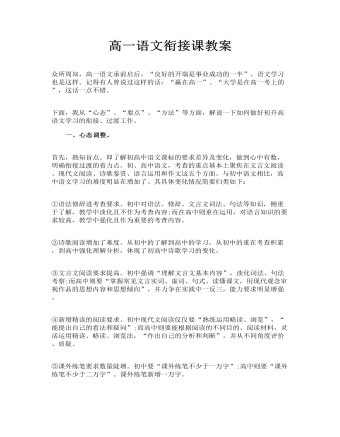
高一语文衔接课教案
一、心态调整。 首先,熟知盲点。即了解初高中语文课标的要求差异及变化,做到心中有数,明确衔接过渡的着力点。初、高中语文,考查的重点基本上聚焦在文言文阅读、现代文阅读、诗歌鉴赏、语言运用和作文这五个方面。与初中语文相比,高中语文学习的难度明显在增加了。其具体变化情况简要归类如下: ①语法修辞进考查要求。初中对语法、修辞、文言文词法、句法等知识,侧重于了解,教学中淡化且不作为考查内容;而在高中则重在运用,对语言知识的要求较高,教学中强化且作为重要的考查内容。 ②诗歌阅读增加了难度。从初中的了解到高中的学习,从初中的重在考查积累,到高中强化理解分析,体现了初高中诗歌学习的变化。
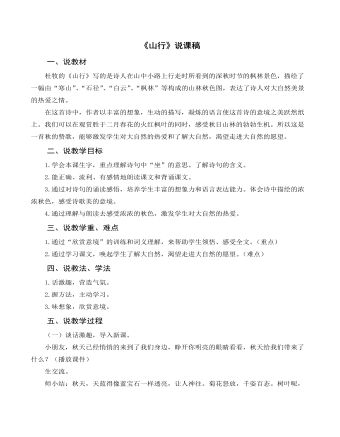
部编人教版三年级上册《古诗三首 山行》说课稿
二、说教学目标1.学会本课生字,重点理解诗句中“坐”的意思。了解诗句的含义。2.能正确、流利、有感情地朗读课文和背诵课文。3.通过对诗句的诵读感悟,培养学生丰富的想象力和语言表达能力。体会诗中描绘的浓浓秋色,感受诗歌美的意境。4.通过理解与朗读去感受浓浓的秋色,激发学生对大自然的热爱。 三、说教学重、难点 1.通过“欣赏意境”的训练和词义理解,来帮助学生领悟、感受全文。(重点)2.通过学习课文,唤起学生了解大自然,渴望走进大自然的愿望。(难点)四、说教法、学法1.话激趣,营造气氛。2.握方法,主动学习。3.味想象,欣赏意境。五、说教学过程(一)谈话激趣,导入新课。小朋友,秋天已经悄悄的来到了我们身边,睁开你明亮的眼睛看看,秋天给我们带来了什么?(播放课件)生交流。
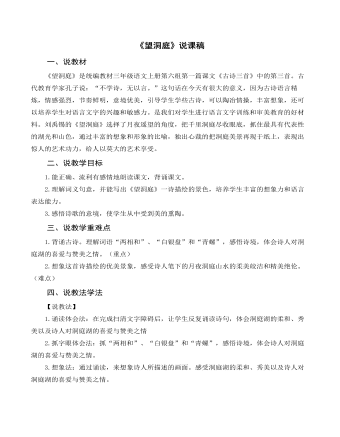
部编人教版三年级上册《古诗三首 望洞庭》说课稿
一、说教材《望洞庭》是统编教材三年级语文上册第六组第一篇课文《古诗三首》中的第三首。古代教育学家孔子说:“不学诗,无以言。”这句话在今天有很大的意义,因为古诗语言精炼,情感强烈,节奏鲜明,意境优美,引导学生学些古诗,可以陶冶情操,丰富想象,还可以培养学生对语言文字的兴趣和敏感力。是我们对学生进行语言文字训练和审美教育的好材料。刘禹锡的《望洞庭》选择了月夜遥望的角度,把千里洞庭尽收眼底,抓住最具有代表性的湖光和山色,通过丰富的想象和形象的比喻,独出心裁的把洞庭美景再现于纸上,表现出惊人的艺术功力,给人以莫大的艺术享受。二、说教学目标1.能正确、流利有感情地朗读课文,背诵课文。2.理解词义句意,并能写出《望洞庭》一诗描绘的景色,培养学生丰富的想象力和语言表达能力。3.感悟诗歌的意境,使学生从中受到美的熏陶。三、说教学重难点1.背诵古诗。理解词语“两相和”、“白银盘”和“青螺”,感悟诗境,体会诗人对洞庭湖的喜爱与赞美之情。(重点)2.想象这首诗描绘的优美景象,感受诗人笔下的月夜洞庭山水的柔美皎洁和精美绝伦。(难点)

部编人教版六年级上册《古诗三首》说课稿
二、说教学目标 1.读准多音字“曲”,会写2个生字。 2.有感情地朗读课文,背诵课文,默写《江南春》。 3.能结合注释,用自己的话说出诗句的意思,读懂诗歌大意。 4.能说出《浪淘沙》是怎样写出黄河的雄伟气势的。 5.能感悟《江南春》是抓住了哪些景物写出了江南春天的特点的。 6.结合诗句,初步感受古诗中的对偶句。 三、说教学重难点1.有感情地朗读课文,背诵课文,默写《江南春》;能理解诗歌大意,体会诗歌写法;结合诗句,初步感受古诗中的对偶句。2.能理解诗歌大意,体会诗歌写法;结合诗句,初步感受古诗中的对偶句。3.想象诗歌描绘的祖国大好河山的壮丽景色,体会诗人的情感。四、说教法学法 教学中采用“创设情境入诗境——想象画面解诗意——吟诵诗词品情感”的教学方法,注重图文结合,抓字眼、抓想象、抓吟诵。体现《语文课程标准》“以读为本”的理念,让朗读贯穿整个教学过程。在读中感受古诗优美精湛的语言文字和丰富的人文内涵,在读中引领学生入情入境,在读中有所感悟,在读中受到情感的熏陶。
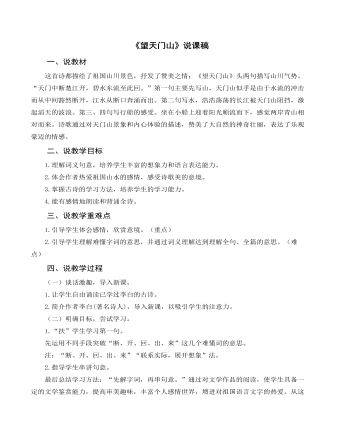
部编人教版三年级上册《古诗三首 望天门山》说课稿
一、说教材这首诗都描绘了祖国山川景色,抒发了赞美之情;《望天门山》头两句描写山川气势。“天门中断楚江开,碧水东流至此回。”第一句主要先写山,天门山似乎是由于水流的冲击而从中间豁然断开,江水从断口奔涌而出。第二句写水,浩浩荡荡的长江被天门山阻挡,激起滔天的波浪。第三、四句写行船的感受。坐在小船上迎着阳光顺流而下,感觉两岸青山相对而来。诗歌通过对天门山景象和内心体验的描述,赞美了大自然的神奇壮丽,表达了乐观豪迈的情感。二、说教学目标1.理解词义句意,培养学生丰富的想象力和语言表达能力。2.体会作者热爱祖国山水的感情,感受诗歌美的意境。3.掌握古诗的学习方法,培养学生的学习能力。4.能有感情地朗读和背诵全诗。三、说教学重难点1.引导学生体会感情,欣赏意境。(重点)2.引导学生理解难懂字词的意思,并通过词义理解达到理解全句、全篇的意思。(难点)
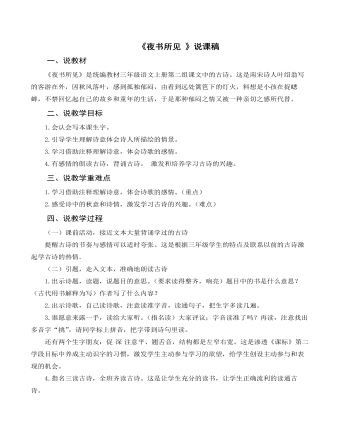
部编人教版三年级上册《古诗三首 夜书所见》说课稿
一、说教材《夜书所见》是统编教材三年级语文上册第二组课文中的古诗。这是南宋诗人叶绍翁写的客游在外,因秋风落叶,感到孤独郁闷,由看到远处篱笆下的灯火,料想是小孩在捉蟋蟀,不禁回忆起自己的故乡和童年的生活,于是那种郁闷之情又被一种亲切之感所代替。二、说教学目标 1.会认会写本课生字。2.引导学生理解诗意体会诗人所描绘的情景。3.学习借助注释理解诗意,体会诗歌的感情。4.有感情的朗读古诗,背诵古诗。 激发和培养学习古诗的兴趣。三、说教学重难点1.学习借助注释理解诗意,体会诗歌的感情。(重点)2.感受诗中的秋意和诗情,激发学习古诗的兴趣。(难点)

部编人教版六年级上册《古诗三首:浪淘沙》 说课稿
一、说教材《浪淘沙》是六年级语文上册第六单元中的一首古诗,这是一首描写黄河雄伟气势的著名诗篇。诗开篇与众多的黄河诗一样,着力描写九曲黄河大浪淘沙之势。紧接着著张骞穷河源遇牛郎、织女的典故,再把“黄河之水天上来”更形象化。在王之涣、李白之外,另辟一条境界,增添了一层奇妙的神话色彩。全诗立意新颖,思想深刻,明快清新。表现了诗人奋发有力的精神和豪迈浪漫的气魄。二、说学情学生在经过了五年的语文学习后,已经形成了一定的诗歌的学习方法和学习步骤,能通过资料以及对背景的了解对诗歌的大意进行自学理解。但同时,学生还存在理解诗歌有时不够深入,缺乏自己的思考过程,特别是在体悟诗歌情境上有着明显的不足。因此,教师在教学中应着力培养学生联系上下文赏析诗歌的意识和习惯的同时,需帮助学生在头脑中更好的建构起诗中情境画面,让学生由诗句产生丰富的联想,体会诗歌的意象美。
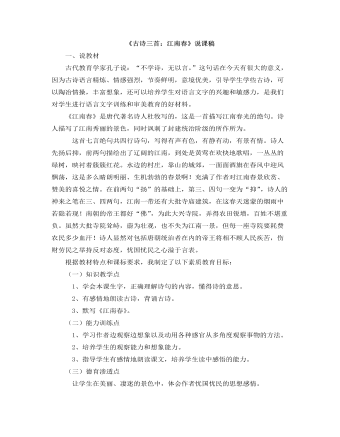
部编人教版六年级上册《古诗三首:江南春》 说课稿
在这样的情境下,学生情趣盎然,紧接着把学生带进新课,点击课件出示配景诗《江南春》,板书课题,齐读课题。接着检查学生的预习情况,每一上新课之前,我都要求学生进行预习,以此来培养学生独立自学能力和良好的学习习惯。然后让学生尝试说说,从题目中,你知道了什么?或你想知道什么?根据学生所说的和所提的,老师归纳总结出有价值的内容和问题,以便在学习古诗中深入渗透探究解决问题。(二)知诗人,介绍写作背景让学生把课前收集到的资料对诗人进行简介及介绍写作背景。这样不仅可以培养其收集处理信息的能力,又培养了口头表达能力及听说能力,又为理解古诗内容做好了准备,同时帮助其获取成功的体验,培养他们主动学习的品质。
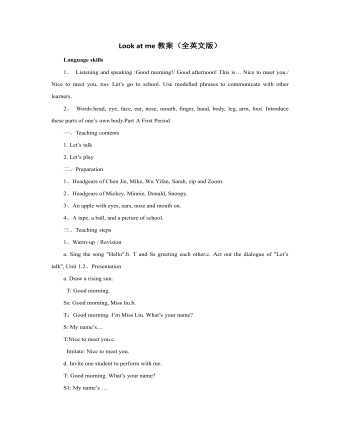
人教版新课标PEP小学英语三年级上册Look at me教案(全英文版)
3、Practicea. Nice to meet you. Nice to meet you,too.b. Perform the dialogue.c. Arrange the dialogue according to the pictures or sentence cards.d. Let’s play.A: Good afternoon,B. This is C. Hello, C! Nice to meet you.C: Nice to meet you, too.A,B: Goodbye!C: Bye!4、Assessment Workbook page 10Add-activitiesa. Listen to the recording and repeat.b. Make a dialogue according to "Let’s talk".Second Period一、Teaching contents1. Let’s learn Words:body, leg, arm, hand, finger, foot.1. Let’s do二、Preparation1、a puppet2、Cards of body, leg, arm, hand, finger and foot.3、headgear of a captain三、Teaching steps1、Warm-up/ Revisiona. Captain says to review "let’s do" of Part A.b. Perform the students their own dialogues.2、Presentationa. Learn to say "body, leg, arm, hand, finger and foot."b. Listen to the recording and repeat.c. Let’s do. Clap your hands. Snap your fingers. Wave your arms. Cross your legs. Shake your body. Stamp your foot.3、Practicea. Let’s draw a person.b. Let’s do. Point out which picture.c. Let’s do. Who responses faster.4、Assessment Workbook page 115、Add-activitiesa. Listen to the recording, repeat and act out.b. Say all the names of the body to your parents.Third Period一、Teaching contents1. Let’s check2. Let’s chant二、Preparation1、stationeries1、pictures of parts of Zoom
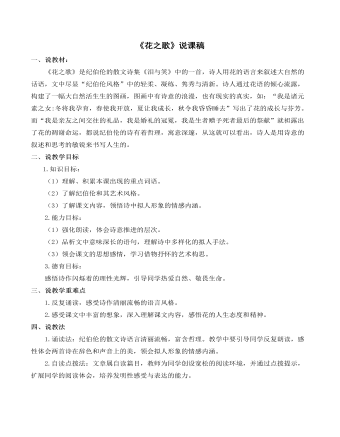
部编人教版六年级上册《花之歌》说课稿
一、说教材: 《花之歌》是纪伯伦的散文诗集《泪与笑》中的一首,诗人用花的语言来叙述大自然的话语,文中尽显“纪伯伦风格”中的轻柔、凝练、隽秀与清新。诗人通过花语的倾心流露,构建了一幅大自然活生生的图画,图画中有诗意的浪漫,也有现实的真实,如:“我是诸元素之女:冬将我孕育,春使我开放,夏让我成长,秋令我昏昏睡去”写出了花的成长与芬芳。而“我是亲友之间交往的礼品,我是婚礼的冠冕,我是生者赠予死者最后的祭献”就袒露出了花的凋谢命运,都说纪伯伦的诗有着哲理,寓意深邃,从这就可以看出,诗人是用诗意的叙述和思考的敏锐来书写人生的。 二、说教学目标 1.知识目标: (1)理解、积累本课出现的重点词语。 (2)了解纪伯伦和其艺术风格。 (3)了解课文内容,领悟诗中拟人形象的情感内涵。
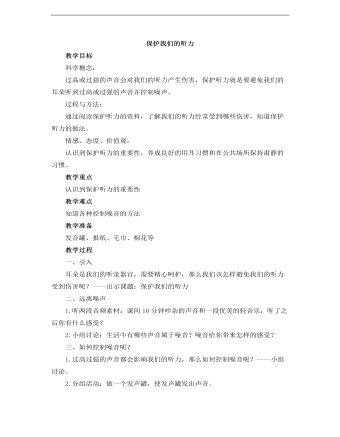
小学科学教科版四年级上册《保护我们的听力》教案
过程与方法:通过阅读保护听力的资料,了解我们的听力经常受到哪些伤害,知道保护听力的做法。情感、态度、价值观:认识到保护听力的重要性,养成良好的用耳习惯和在公共场所保持肃静的习惯。教学重点认识到保护听力的重要性教学难点知道各种控制噪音的方法教学准备发音罐、报纸、毛巾、棉花等

北师大初中数学八年级上册应用二元一次方程组——里程碑上的数1教案
A、B两码头相距140km,一艘轮船在其间航行,顺水航行用了7h,逆水航行用了10h,求这艘轮船在静水中的速度和水流速度.解析:设这艘轮船在静水中的速度为xkm/h,水流速度为ykm/h,列表如下,路程 速度 时间顺流 140km (x+y)km/h 7h逆流 140km (x-y)km/h 10h解:设这艘轮船在静水中的速度为xkm/h,水流速度为ykm/h.由题意,得7(x+y)=140,10(x-y)=140.解得x=17,y=3.答:这艘轮船在静水中的速度为17km/h,水流速度为3km/h.方法总结:本题关键是找到各速度之间的关系,顺速=静速+水速,逆速=静速-水速;再结合公式“路程=速度×时间”列方程组.三、板书设计“里程碑上的数”问题数字问题行程问题数学思想方法是数学学习的灵魂.教学中注意关注蕴含其中的数学思想方法(如化归方法),介绍化归思想及其运用,既可提高学生的学习兴趣,开阔视野,同时也提高学生对数学思想的认识,提升解题能力.